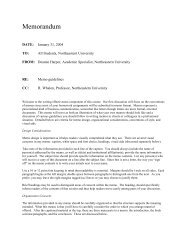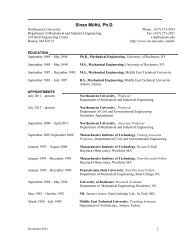An online ergonomic evaluator for 3D product design
An online ergonomic evaluator for 3D product design
An online ergonomic evaluator for 3D product design
Create successful ePaper yourself
Turn your PDF publications into a flip-book with our unique Google optimized e-Paper software.
480<br />
and manufacturing. Integration between heterogeneous<br />
software systems has also become feasible in<br />
the modern IT environment. On the other hand, since<br />
the early 1990s human behavior has been modeled in a<br />
digital <strong>for</strong>m that enables full-scale <strong>ergonomic</strong> evaluation,<br />
both physically and psychologically, in a variety<br />
of industrial applications [2–4]. To incorporate a<br />
digital model that simulates human actions in the<br />
<strong>product</strong> <strong>design</strong> process has been recognized as highly<br />
effective in realizing human-centric <strong>product</strong> <strong>design</strong>.<br />
For instance, vehicle interior <strong>design</strong> is an engineering<br />
task that must cautiously consider <strong>ergonomic</strong> interactions<br />
between the <strong>design</strong> and the end-user. Equipments<br />
in a car should be properly arranged so that the<br />
driver can posture well and feel com<strong>for</strong>table in<br />
driving. Assessments of car setting are usually very<br />
time-consuming and involve multidisciplinary team<br />
members such as engineer, <strong>design</strong>er, <strong>ergonomic</strong><br />
expert, and test user. Complex facilities such as<br />
physical mock-up, virtual reality system, and CAD<br />
software are commonly employed in the assessment<br />
process. The development costs of these <strong>product</strong>s are<br />
consequently increased.<br />
A number of software tools [5–9] have been<br />
developed <strong>for</strong> <strong>ergonomic</strong> <strong>design</strong> of consumer <strong>product</strong>s,<br />
machines, workplaces, and occupational<br />
devices. Most of them utilize full-scale CAD systems<br />
and/or high-end virtual reality environment <strong>for</strong><br />
<strong>ergonomic</strong> estimation [10,11]. However, CAD or<br />
VR tools may not be always available to <strong>product</strong><br />
<strong>design</strong>ers or small/medium enterprises that cannot<br />
af<strong>for</strong>d such costly tools. In addition, any <strong>ergonomic</strong><br />
evaluation <strong>for</strong> consumer <strong>product</strong>s should be conducted<br />
based on appropriate anthropometry data. It is not very<br />
likely that anthropometry databases and <strong>design</strong> tools<br />
are located in one software system within a company,<br />
and thus, the integration between them poses a serious<br />
problem. Finally, customers’ inputs are highly<br />
valuable and most of the time necessary <strong>for</strong> <strong>ergonomic</strong><br />
<strong>design</strong>. However, to obtain their opinions within an<br />
engineering context during the <strong>product</strong> <strong>design</strong> remains<br />
a challenging task. Very little research has addressed<br />
this issue.<br />
This study develops a web-based light-weighted<br />
<strong>ergonomic</strong> <strong>evaluator</strong> <strong>for</strong> vehicle interior <strong>design</strong>. A<br />
digital human model is constructed based on Taiwan<br />
local anthropometry data that enables the user to query<br />
<strong>ergonomic</strong> in<strong>for</strong>mation through a regular browser.<br />
C.-F. Kuo, C.-H. Chu / Computers in Industry 56 (2005) 479–492<br />
The <strong>product</strong> model is simplified from its original <strong>3D</strong><br />
CAD representation, but still retains necessary<br />
in<strong>for</strong>mation <strong>for</strong> the purpose of <strong>ergonomic</strong> evaluation.<br />
This system allows the <strong>3D</strong> human to interact with the<br />
<strong>product</strong> model, thus mimicking the condition in<br />
which a person is sitting in the front seat and driving<br />
the vehicle. Given a posture, physical loads on the<br />
body joints of the digital human can be computed<br />
using the Chaffin’s biomechanical model. In this<br />
manner, the user can interactively adjust the interior<br />
setting until a better <strong>design</strong> is obtained that gives a<br />
more com<strong>for</strong>table posture explicitly <strong>for</strong> the user. This<br />
work demonstrates the feasibility of web-based<br />
ergocentric <strong>product</strong> <strong>design</strong> with no needs of CAD<br />
or VR systems. It provides both the <strong>design</strong>er and endcustomer<br />
1 an easy but effective solution <strong>for</strong> <strong>ergonomic</strong><br />
evaluation of <strong>product</strong> development at the early <strong>design</strong><br />
stage.<br />
2. Research approaches<br />
2.1. Digital human modeling<br />
<strong>3D</strong> virtual humans have been used in many<br />
engineering and entertainment applications since the<br />
early 1990s. For example, interactive computer<br />
models have served as a substitute <strong>for</strong> ‘‘the real<br />
human’’ in the <strong>ergonomic</strong> evaluation <strong>for</strong> <strong>design</strong>s of<br />
vehicles, work areas, machine tools, occupational<br />
devices, etc. prior to the actual construction [12–14].<br />
They successfully provide a real-time representation<br />
of human beings or other live participants embedded<br />
in virtual environment. In addition, the <strong>design</strong>er is able<br />
to collect customers’ feedback based on a digital<br />
model that simulates human behaviors both physically<br />
and psychologically at the early concept <strong>design</strong> phase.<br />
In addition, such a digital human can carry useful<br />
in<strong>for</strong>mation like body shapes, dimensions, motion<br />
constraints, and operation sequences in <strong>3D</strong> space that<br />
must be taken into account in detailed <strong>design</strong>.<br />
Allowing the end-user, characterized by the digital<br />
human, to interact with the <strong>product</strong> model facilitates<br />
<strong>product</strong> personalization as the <strong>design</strong> process evolves.<br />
1 Both the professional <strong>design</strong>er and the general customer can use<br />
the proposed <strong>ergonomic</strong> evaluation system. There is no direct link<br />
between these two roles. ‘‘The user’’ can mean either one depending<br />
on the context in this paper.









